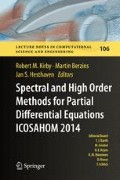Abstract
In this work we compare different families of nested quadrature points, i.e. the classic Clenshaw–Curtis and various kinds of Leja points, in the context of the quasi-optimal sparse grid approximation of random elliptic PDEs. Numerical evidence suggests that both families perform comparably within such framework.
Access this chapter
Tax calculation will be finalised at checkout
Purchases are for personal use only
Notes
- 1.
Also known as admissible sets or lower sets, i.e. such that \(\forall \,\mathbf{i} \in \mathcal{I}(\mathrm{w})\) and \(\forall \,\mathbf{j} \in \mathbb{N}_{+}^{N}\) s.t. j ≤ i, there holds \(\mathbf{j} \in \mathcal{I}(\mathrm{w})\), where the inequality is to be understood component-wise.
- 2.
When 2m + 1 p-Disk Leja points are computed, they coincide with the Clenshaw–Curtis points.
References
I. Babuška, F. Nobile, R. Tempone, A stochastic collocation method for elliptic partial differential equations with random input data. SIAM Rev. 52(2), 317–355 (2010)
J. Beck, F. Nobile, L. Tamellini, R. Tempone, On the optimal polynomial approximation of stochastic PDEs by Galerkin and collocation methods. Math. Models Methods Appl. Sci. 22(09) (2012)
J. Beck, F. Nobile, L. Tamellini, R. Tempone, A quasi-optimal sparse grids procedure for groundwater flows, in Spectral and High Order Methods for Partial Differential Equations - ICOSAHOM 2012. Lecture Notes in Computational Science and Engineering, vol. 95 (Springer International Publishing, Switzerland, 2014), pp. 1–16
H. Bungartz, M. Griebel, Sparse grids. Acta Numer. 13, 147–269 (2004)
A. Chkifa, On the Lebesgue constant of Leja sequences for the complex unit disk and of their real projection. J. Approx. Theory 166(0), 176–200 (2013)
A. Chkifa, A. Cohen, C. Schwab, High-dimensional adaptive sparse polynomial interpolation and applications to parametric PDEs. Found. Comput. Math. 14(4), 601–633 (2014)
A. Cohen, R. Devore, C. Schwab, Analytic regularity and polynomial approximation of parametric and stochastic elliptic PDE’S. Anal. Appl. 9(1), 11–47 (2011)
T. Gerstner, M. Griebel, Dimension-adaptive tensor-product quadrature. Computing 71(1), 65–87 (2003)
M. Griebel, S. Knapek, Optimized general sparse grid approximation spaces for operator equations. Math. Comput. 78(268), 2223–2257 (2009)
A. Narayan, J.D. Jakeman, Adaptive Leja sparse grid constructions for stochastic collocation and high-dimensional approximation. SIAM J. Sci. Comput. 36(6), A2952–A2983 (2014)
F. Nobile, L. Tamellini, R. Tempone, Convergence of quasi-optimal sparse-grids approximation of Hilbert-space-valued functions: application to random elliptic PDEs. Accepted for publication on Numerische Mathematik. Also available as Mathicse report 12/2014, EPFL
C. Schillings, C. Schwab, Sparse, adaptive Smolyak quadratures for Bayesian inverse problems. Inverse Probl. 29(6) (2013)
D. Xiu, J. Hesthaven, High-order collocation methods for differential equations with random inputs. SIAM J. Sci. Comput. 27(3), 1118–1139 (2005)
Acknowledgements
F. Nobile and L. Tamellini have been partially supported by the Swiss National Science Foundation under the Project No. 140574 “Efficient numerical methods for flow and transport phenomena in heterogeneous random porous media” and by the Center for ADvanced MOdeling Science (CADMOS). R. Tempone is a member of the KAUST SRI Center for Uncertainty Quantification in Computational Science and Engineering.
Author information
Authors and Affiliations
Corresponding author
Editor information
Editors and Affiliations
Rights and permissions
Copyright information
© 2015 Springer International Publishing Switzerland
About this paper
Cite this paper
Nobile, F., Tamellini, L., Tempone, R. (2015). Comparison of Clenshaw–Curtis and Leja Quasi-Optimal Sparse Grids for the Approximation of Random PDEs. In: Kirby, R., Berzins, M., Hesthaven, J. (eds) Spectral and High Order Methods for Partial Differential Equations ICOSAHOM 2014. Lecture Notes in Computational Science and Engineering, vol 106. Springer, Cham. https://doi.org/10.1007/978-3-319-19800-2_44
Download citation
DOI: https://doi.org/10.1007/978-3-319-19800-2_44
Publisher Name: Springer, Cham
Print ISBN: 978-3-319-19799-9
Online ISBN: 978-3-319-19800-2
eBook Packages: Mathematics and StatisticsMathematics and Statistics (R0)

